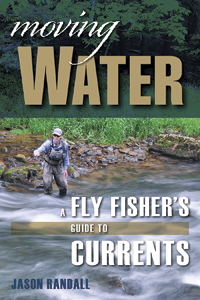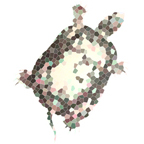Archive for category Ichthyology
Book Review: Moving Water
Posted by Matthew Bettelheim in Book Reviews, Entomology, Field Guide, Fisheries, Ichthyology, Natural History on October 8, 2013
Moving Water: A Fly Fisher’s Guide to Currents, by Jason Randall, Stackpole Books (www.stackpolebooks.com), 2012, 209 pages, $ 24.95.

If you’ve spent any time on the water, you understand just how seemingly complex and unpredictable moving water can be. Whether you’ve floated the American River in a guided raft, angled the Sacramento River from a drift boat, or simply ambled along a surging river after a torrential storm, the turbulent water appears chaotic and feral. But like anything else on Earth, water is bound by the same laws of physics. Despite the froth and churn of a roiling river, one should be able to disassemble and predict how moving water might interact in any given system.
Enter angler Jason Randall, whose Moving Water: A Fly Fisher’s Guide to Currents tackles the conundrum of currents from the angler’s angle. Even though Moving Water‘s intended audience is clearly fishermen, Randall’s narrative appeals equally to a broader audience of anyone interested in the nuts and bolts of how rills and rivers work. Whether you’re an angler or outdoorsman or fisheries biologist or naturalist, understanding the nuances and mechanics of moving water is a currency in and of itself. The effects of current influence not only fish (and how to fish for them), but also the vertical and horizontal distribution of invertebrates and plants; the geomorphology of a river’s channel, riparian zone, and floodplain; and the distribution and foraging strategies of other river-dwelling wildlife species.
Beginning with a review of lotic ecosystems (those of the river and stream), Randall first outlines the basics of water and flow, describing how moving water shapes not only a river, but the surrounding landscape. Key in this discussion are the mechanics and interplay of velocity, centrifugal force, water oscillations, and gravity, which together are responsible for the character and meander of a channel in a lotic system. Next Randall slips into a chapter on laminar flow, the effect of friction that results in a layering effect in water velocity in a column of flowing water. With these concepts in place, Randall puts the pieces together in the three-dimensional river, plunging below the waterline to examine vertical stratification and variation in current velocities caused by such obstructions as bank and bottom, rocks and logs. Next is a discussion of turbulence, the wildcard that introduces randomness and chaos to moving water, but also facilitates gas exchange and mixing of organic and inorganic materials. Lastly, Randall devotes a chapter each to the benthic community and fish behavior, tying everything together like a fisherman’s knot.
Although the entire text is framed by how moving water effects the drag on a line or fly, and how to mend or cast to alleviate such drag, discerning non-anglers should find it easy enough to apply these principles of moving waters more broadly to their own disciplines and interests. Randall writes with the authority and expertise of an angler, but does so with patience for the uninitiated. In Moving Waters, Randall brings the river, and the water that runs through it, to life.
Book Review: Color Catalogue for Field Biologists
Posted by Matthew Bettelheim in Book Reviews, Botany, Entomology, Field Guide, Fisheries, Herpetology, Ichthyology, Mammalogy, Natural History, Ornithology on June 3, 2013
 Color Catalogue for Field Biologists, by Gunther Köhler, Herpeton (http://www.herpeton-verlag.de/), 2012, 49 pages, € 24.80 (~$32.00).
Color Catalogue for Field Biologists, by Gunther Köhler, Herpeton (http://www.herpeton-verlag.de/), 2012, 49 pages, € 24.80 (~$32.00).
For years, when it came to describing a species in the field, the gold standard in color standards was Frank B. Smithe’s “Naturalist’s Color Guide”. The Smithe Guide provided a palette of 182 color swatches against which to compare and discern the colors in a hummingbird’s ruby gorget feather or the cobalt venter scales of a “blue belly” western fence lizard. Much like the Munsell color system – familiar to many through the Munsell soil color charts used in the field by soil scientists for, among other things, wetland delineations – the Smith Guide was the go-to-guide for wildlife biologists and taxonomists who needed to record accurate and reproducible species descriptions. When the Smith Guide went out of print in 1981, it left a gap in the suite of references available to scientists.
With the publication of Gunther Köhler’s Color Catalogue for Field Biologists, that gap is once again filled. Picking up where the Smithe Guide left off, the ‘Köhler Catalogue’ builds off the 182 original swatches with an additional 118 swatches that span the spectrum from Kingfisher Rufous and Pistachio to Light Russet Vinaceous and Cinnamon Drab. The Köhler Catalogue boasts many features, amongst them an English/Spanish translation, an introductory glossary of terms (e.g. stipples vs dots), photographic figures illustrating key terms, and a primer on preparing color descriptions in life. The heavy card stock, heavy duty front and back covers, and spiral-bound spine show that the Köhler Catalogue is meant to get dirty.
Although the guide is geared toward herpetologists (the terms and photographs, for example, illustrate the art of describing amphibians and reptiles), even Köhler admits its utility for ichthyologists, ornithologists, entomologists, botanists, and – although he neglects to mention them – mammalogists. But no matter the taxon, nowadays when you find yourself at a loss for words to describe a new species or a new specimen – be it bird or bee – you can turn to the Köhler Catalogue.

